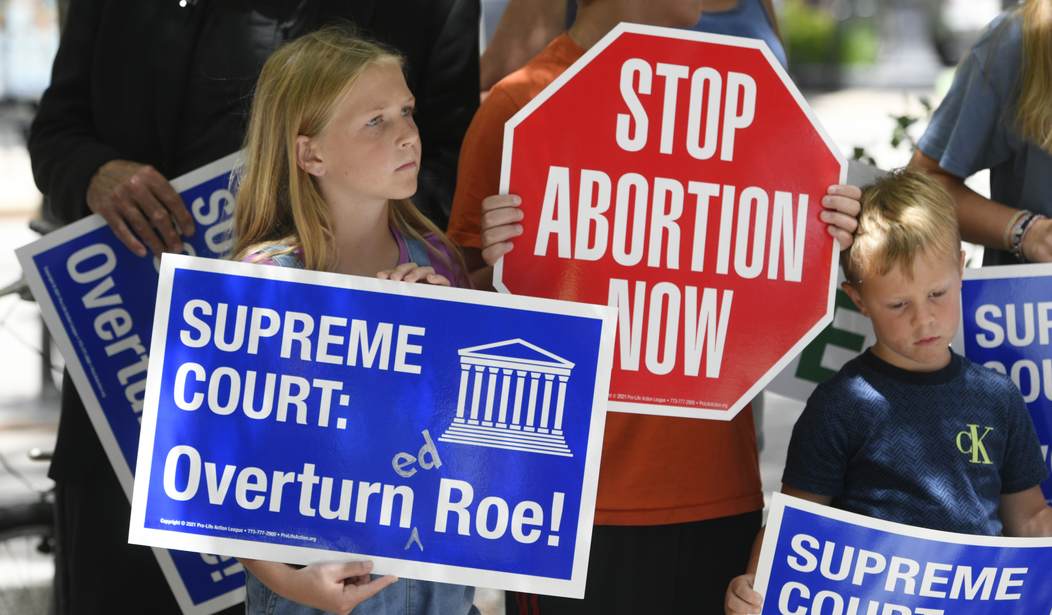In June, Townhall reported how many states across the country enacted groundbreaking life-affirming measures to protect the unborn. This came after the Supreme Court overturned Roe v. Wade, sending shockwaves across the country. Many states passed bans to outlaw abortion after fetal heartbeat detection, and some enacted their own unique laws prohibiting telemedicine abortions and abortion trafficking.
However, new data from an organization once affiliated with Planned Parenthood is claiming that abortions increased substantially at the beginning of 2023, months after the Supreme Court's ruling. This, they claim, has occurred because women are traveling for abortions or taking abortion pills.
According to the data from the pro-abortion Guttmacher Institute, legal abortions likely increased in the first six months of 2023 compared to 2020.
Guttmacher claims that around 465,000 abortions occurred in all 50 states and Washington D.C. in the first six months of 2020. In 2023, the numbers show, around 511,000 abortions took place across 36 states and Washington D.C.
Before the Supreme Court overturned Roe v. Wade in 2022, the pro-abortion lobby claimed that women would not be able to obtain abortions. However, the research shows that abortions through telemedicine continued to expand and states with lenient abortion laws absorbed patients from states with strict ones (via The New York Times):
Recommended
Abortions rose in nearly every state where the procedure remains legal, but the change was most visible in states bordering those with total abortion bans. Many of these states loosened abortion laws, and providers opened new clinics to serve patients coming from elsewhere. In Illinois, for example, where abortion is legal, abortions rose an estimated 69 percent in 2023 compared with the same period in 2020, to about 45,000 from 26,000.
Other states with restrictive neighbors, like Colorado, Kansas, New Mexico and South Carolina, also had jumps in estimated counts of abortions.
Arizona, Georgia and Indiana, by contrast, sought to restrict abortion, and all three states had drops in their estimates. Arizona and Georgia have gestational limits on the procedure, and Indiana recently enacted a total ban.
National Review pointed out that the "spin" on the story from mainstream media "has been that pro-life laws enacted since the Dobbs decision have been in effective at reducing the incidence of abortion" :
Unsurprisingly, there is much less here than meets the eye. This is for several reasons. First, these new abortion estimates are based on samples of abortion facilities, not comprehensive surveys. Guttmacher provides 90 percent confidence intervals that often reflect a great deal of potential variance in their state-level abortion estimates. For Georgia, their upper abortion estimate is over 80 percent higher than their low estimate. For Florida, their upper estimate is more than 11,000 abortions higher than their low estimate. This much variation raises serious questions about the accuracy of their estimates.
Additionally, not all of the abortion increases in politically liberal states are due to more out-of-state women seeking abortions. Part of the increase is likely due to a recent national trend. Between 2017 and 2020, data from both the CDC and Guttmacher found a slight increase in the incidence of abortion. Also, part of the increase can be attributed to some blue states’ having made their abortion policy even more permissive. In recent years Illinois, Maine, and Rhode Island have all started to cover elective abortion through their respective state Medicaid programs. Finally, part of the increase is likely due to CDC policies that have made chemical abortions easier to access — specifically, policies allowing women to obtain chemical-abortion pills without an in-person medical exam.
Overall, plenty of reliable data collected since the Dobbs decision show that thousands of lives have been saved by strong state-level pro-life laws. The #WeCount project, sponsored by the Society of Family Planning, attempts to count — not estimate — the number of abortions that have been performed since July 2022. They have consistently found that tens of thousands of fewer abortion have taken place since Dobbs. Also, my November 2022 Lozier Institute study and a June 2023 article in the Journal of the American Medical Association both show that the Texas Heartbeat Act has resulted in over 1,000 more children being born every month in the Lone Star State
In the aftermath of Dobbs, abortion became a hot-button issue and continues to be one ahead of the 2024 presidential election. In the first GOP presidential debate, several candidates butted heads over their stances on abortion, which Townhall covered.
Last month, as Townhall covered, the South Carolina Supreme Court ruled that the state’s six-week “heartbeat” legislation is constitutional. In the debate, when asked about her stance on abortion, Haley argued that she is “unapologetically pro-life” but that Republicans need to be “realistic” and “honest with the American people.”
“It will take 60 Senate votes, it will take a majority of the House,” she said, noting that there has not been that many pro-life elected officials in years. She then called for “consensus” on the issue, specifically, banning third-trimester abortions.
“Can't we all agree that we should ban late-term abortions?" she stated. "Can't we all agree that we should encourage adoptions? Can't we all agree that doctors and nurses who don't believe in abortion shouldn't have to perform them? Can't we all agree that contraception should be available? And, can't we all agree that we are not going to put a woman in jail or give her the death penalty if she gets an abortion?”
HALEY: "Can't we all agree that we are not gonna put a woman in jail or give her the death penalty if she gets an abortion?" pic.twitter.com/lemnc68Ez2
— Breaking911 (@Breaking911) August 24, 2023
In response, Pence said that “consensus is not leadership” on the issue of abortion.
"To be honest with you, Nikki, you're my friend, but consensus is the opposite of leadership," Pence said. "They didn't just send it to the states only. It's not a states-only issue, it's a moral issue."
“I promise you, as president of the United States, the American people will have a champion for life in the Oval Office. Can’t we have a minimum standard in every state in the nation that says when a baby is capable of feeling pain, an abortion be allowed?” he said. “It’s going to take unapologetic leadership.”
Heated exchange here between Mike Pence and Nikki Haley on abortion as Pence challenges her: "To be honest with you Nikki, you're my friend, but consensus is the opposite of leadership." pic.twitter.com/Ea1i3qb4wf
— Mary Margaret Olohan (@MaryMargOlohan) August 24, 2023

























